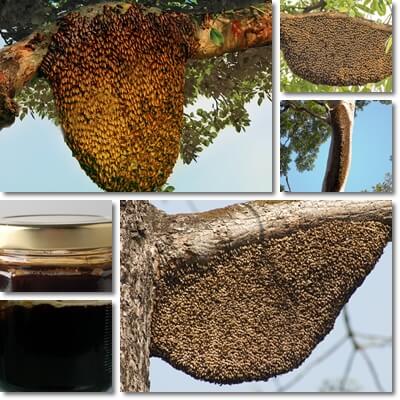Tualang honey is a variety of honey produced and harvested in the rainforests of south and southeast Asia. The natural honey comes in three color variants, yellow or gold, red and black, with both color and taste varying according to floral sources. Tualang honey is a particularly healthy honey, high in antioxidants and with an antibacterial activity comparable to that of Manuka honey. Studies show tualang honey modulates the immune system and exerts anti-inflammatory and anticancer effects.
Tualang honey has both medicinal properties and cosmetic uses and can be applied topically to help with healing of small wounds and to improve appearance of dry and oily skin.
What does tualang honey taste and look like?
There are 3 main types of tualang honey: yellow, gold or golden tualang honey, red tualang honey and black tualang honey (which is actually a very dark brown color). The honey is slightly more watery and can form a foam on top which is a sign of a natural honey that is utterly unprocessed (not heated and likely not filtered either, or not excessively or finely filtered). Tualang honey taste also varies according to color, year, season and flower sources in the honey. The variety has a somewhat stronger taste than typical honey varieties, with a medium taste intensity and a light floral aroma with both bitter and sweet flavor notes.
Find out more about tualang honey.

Tualang honey nutritional information
There is little information available on the nutrition of tualang honey, mainly because it is a relatively ‘new’ honey, but also because extensive research is needed to account for the differences in the nutritional status of the different types of tualang honey (yellow/gold, red and brown/black tualang honey) from different regions.
This being said, tualang honey is nutritionally similar to most honeys in the sense that it is mostly sugar and water (most honeys are roughly 80% sugar and 13% to 17% water). The rest is amino acids, vitamins, minerals, and enzymes, with over 180 different natural compounds present in the honey (source).
It is known that tualang honey is somewhat watery in consistency which would indicate a slightly higher water content. In a comparison with manuka honey, a dark brown variety of tualang honey was found to have a moisture content of 23.3% while manuka honey 18.7%. The studied sample of tualang honey had a ratio of fructose to glucose of almost 1:1 (29.6% fructose, 30% glucose).
Essential vitamins and minerals account for roughly around 1% of the total honey content which is why it’s not accurate to describe tualang, or any honey variety for that matter, as being extremely nutritious, or even nutritious. The pH of tualang honey is 3.55 to 4 which is a low pH, meaning the honey is naturally acidic.
Tualang honey nutrition facts
- Water content: 23.3%
- Sugar content – fructose: 29.6%
- Sugar content – glucose: 30%
- Sugar content – other sugars: maltose – 7.9%, sucrose 0.6%
- Calcium: 0.18%
- Magnesium: 0.11%
- Potassium: 0.51%
- Sodium: 0.26%
- Vitamins: vitamin C, B vitamins (no vitamin B12) – trace amounts

What is tualang honey good for?
Natural honey
Tualang honey is a natural honey, that is, produced in a natural environment, in the wild (southern and southeastern rainforests in Asia), without human intervention, and harvested from the wild. Tualang honey harvesting implies going up tualang trees in the rainforest and collecting the honey combs with honey in a bucket.
More biologically active than Manuka honey
Research reveals tualang honey contains more biologically active phenolic acids, flavonoids and other polyphenols than Manuka honey and other studied Malaysian honeys. Distinct differences include higher phenolics, flavonoids, and 5-(hydroxymethyl) furfural (HMF) (source).
High antioxidant content
Antioxidants are compounds occurring naturally in plants that scavenge for reactive oxygen species called free radicals that cause oxidative stress and damage to cells. Antioxidants reduce the formation of or neutralize free radicals and help prevent, limit and repair cell damage, contributing to lower inflammation markers and reduced risks of chronic disease.
A total of six phenolic acids (gallic, syringic, benzoic, transcinnamic, p-coumaric, and caffeic acids) and five flavonoids (catechin, kaempferol, naringenin, luteolin and apigenin) are found in tualang honey, as well as stearic acids, 2-cyclopentene-1,4,-dione, 2[3H]-furanone or dihydro-butyrolactone, gamma-crotonolactone or 2[5H]-furanone, 2-hydroxy-2-cyclopenten-1-one, hyacinthin, 2,4-dihydroxy-2,5-dimethyl-3[2H]-furan-3-one, and phenylethanol.
The total phenolic content of tualang honey is correlated with color intensity (source) so the darker tualang honey varieties are presumed to hold a greater phenolic value and antioxidant benefits.
Strong natural antibacterial properties
The antimicrobial effects of tualang honey are owed to the honey’s acidic pH which inhibits bacterial growth, high sugar content which makes the honey deposit as a protective film over surfaces, preventing bacterial infection, and peroxidase and non-peroxidase components with antimicrobial properties.
Tualang honey contains natural peroxidase antibacterial agents such as hydrogen peroxide and gluconic acid which actively inhibit bacteria growth and reduce bacterial load, and non peroxidase antibacterial compounds such as phenolic acids, flavonoids, and lysozymes with bactericidal and bacteriostatic properties against a range of bacteria, including common bacteria on the skin.
Studies show tualang honey has variable but broad-spectrum activities against many different species of wound and enteric bacteria, and showed good antimicrobial activity against Gram-negative bacteria such as Stenotrophomonas maltophilia, Acinetobacter baumannii, Escherichia coli, Salmonella typhi, Streptococcus pyogenes and even MRSA (source).
Antibacterial action comparable to that of Manuka honey
Research shows tualang honey has an antibacterial action comparable to that of Manuka honey for a range of Gram-negative and Gram-positive bacteria. But compared with Manuka honey, tualang honey shows greater antibacterial activity against A. baumannii and is more effective against some gram-negative bacterial strains occurring in burn wounds (source). Tualang honey causes greater inhibition of MRSA than Manuka honey at concentrations higher than 11% (source).
Immune boosting action
Tualang honey exerts an immune system boosting action via several pathways. For one, the raw honey is contains dozens to hundreds of different pollen sources which activate the immune system response, triggering a cascade of events that culminate with clearing away pathogens (viruses, bacteria, fungi, parasites) and small infections, but also cancer cells.
The honey also exerts a bactericidal action, that is, it destroys pathogens such as Gram-negative and Gram-positive bacteria, and bacteriostatic, inhibiting bacteria growth, actively supporting the immune system.
Tualang honey benefits for cancer
Like all honeys, tualang too has some degree of anticancer benefits. Tualang honey is high in antioxidant components that scavenge for reactive oxygen species called free radicals, reducing the formation of and neutralizing free radicals which is believed to provide a varying degree of protection against cancer. The honey has known anti-inflammatory properties which contribute to its anticarcinogenic action as inflammation is a risk factor for cancer.
Tualang honey has immuno-modulatory effects which support, activate and even improve the immune function and induces apoptosis, programmed cell death, in cancer cells (source 1), with a significant anticancer activity observed against cervical and breast cancer cells (source), human osteosarcoma (source) and squamous cell carcinoma (source).
Tualang honey benefits for diabetes
Despite being mostly sugar, albeit natural, honey does have antidiabetic benefits. Tualang honey from Malaysia was found to have a glycemic index score of 65 which makes it a moderate GI food with somewhat limited effects on blood sugar (source).
Tualang honey was also found to increase insulin levels and reduce high blood sugar levels and animal studies suggest tualang honey in combination with diabetes medication such as metformin may contribute to better glycemic control in diabetics (source). However, intakes should remain limited to very small amounts because the honey is still mostly sugar and will raise blood sugar levels excessively if consumed unreasonably.
Tualang honey benefits for wound healing
Tualang honey has scientifically proven antibacterial effects which have led to it being considered for wound dressing with the purpose of promoting faster wound healing. Indeed, the honey inhibits bacteria growth and destroys bacteria, lowers inflammation levels as well as provides a high antioxidant content, all of which contribute to wound healing effects.
Tualang honey for fertility
Emerging research suggests tualang honey can boost fertility in both men and women and potentially improve pregnancy outcomes. In women, tualang honey can potentially increase levels of certain hormones, while in men it reduces the toxic effects of cigarette smoke and improves testosterone level, with direct benefits for fertility (source). Tualang honey has also been shown to protect the uterus against BPA toxicity and associated endocrine disruptions leading to hormone imbalances (source).
Tualang honey for menopause
Animal studies suggest eating tualang honey can provide protective and beneficial effects for postmenopausal women such as preventing uterine atrophy, promoting increased bone density with lower risks of osteoporosis, and counteracting weight gain associated with post-menopausal age (source).
Potential benefits for memory and learning
According to research, post-menopausal women to ate tualang honey experienced some improvement in their immediate memory (source). Animal studies also suggest the honey can potentially improve memory via its high antioxidant content (source) and potentially support learning and intellectual effort.
Combats hypoglycemia
Hypoglycemia is a state of very low blood sugar levels and can cause irritation, agitation, anxiety, palpitations, flushing, cold sweats, lightheadedness and dizziness and even fainting. Eating a tablespoon of tualang honey can instantly raise blood sugar levels, providing quick energy for the body to use.
Benefits for dry skin, oily skin and dull skin
Tualang honey can be applied onto and massaged into the skin to combat dryness, hydrate and nourish the skin. Used as a face mask and cleared away with warm water, it helps clear excess sebum without stripping away too much of the natural oils, balancing skin sebum levels. Rich in antioxidants, tualang honey exerts antiaging effects and helps achieve a brighter and healthier skin.
Tualang honey side effects, risks and contraindications
- Allergic reactions. It is possible to experience an allergic reaction to tualang honey. Avoid consumption if you already have an allergy to other honey varieties or honey bee products, or more than one pollen source.
- Contraindications: children under 1 year of age. Honey, raw honey more exactly, while healthy, is contraindicated for children under 1 year of age due to risks of botulism.
- Contamination risks. While produced in a pristine environment, tualang honey is not a pasteurized food product and thus carries a low risk of contamination with bacteria, fungi, spores and various microorganisms which can be introduced in the honey via improper handling.
- Adulteration. Currently, demand for tualang honey is higher than supply which means that there may likely be instances of adulteration, that is, corn syrup or other honeys are made to look and taste like tualang honey. To protect yourself from adulterated products, only buy tualang honey from reputable sources and brands and check the label for certifications, or inquire with the retailer about where the honey is from, what season and any information you may consider vital.
